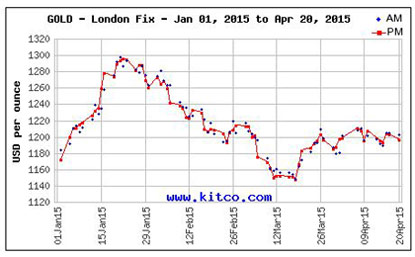Between unrest in the Middle East, government bonds with negative yields, and international central bank stimulus measures, there’s certainly no shortage of reasons to own gold this year.
And of the many ways to add the yellow metal to your portfolio, a gold ETF is a convenient option. 
Gold acts like an insurance policy against geopolitical woes, devalued currencies, deflation, and inflation. It’s also a good portfolio diversifier.
Gold prices are low right now, so it’s a great time to buy. After a January rally took gold up 11% over two and a half weeks, prices stumbled. Gold’s year-to-date gains have now faded to 2.5%.
But Money Morning Resource Specialist Peter Krauth recently listed several reasons he believes gold prices will see better days ahead. He predicts gold will rise from its current level ($1,199 an ounce at time of writing) to end Q2 in the $1,250 to $1,270 range.
Here’s a look at what a gold ETF can offer investors – plus five top gold ETFs to get started with today…
Gold ETFs Offer Ease and Convenience
Investors have a number of options when buying gold.
Those who prefer physical gold can purchase bars, jewelry, or coins. But investing in physical gold typically requires expensive and sometimes complicated arrangements in connection with transportation, warehousing, and insurance.
Gold stocks and mutual funds are another option.
Finally, gold exchange-traded funds (ETFs) are an increasingly popular choice.
Gold ETFs provide investors with exposure to the yellow metal by tracking the price of gold. This allows investors to profit from gold’s price gains without having to own physical bullion, for a more convenient and liquid way to own and trade gold.
According to ETF.com, there are currently 38 ETFs that invest in gold. That’s up from 16 in 2010.
Following are the top four gold ETFs by assets and average daily volume. We’ve also included one that lets you exchange shares for physical gold.
A Gold ETF List for 2015
Gold ETF No. 1: SPDR Gold Trust ETF (NYSE Arca: GLD) is by far the largest and most widely traded gold ETF. It aims to track the price of gold. Launched on Nov. 18, 2004, GLD has some $28.12 billion in assets. Average daily volume is 6,209,605. GLD is up 1.3% year to date.
Gold ETF No. 2: iShares Gold Trust ETF (NYSE Arca: IAU) is the second-largest and most actively traded gold ETF. Its goal is to reflect gold’s price movements. IAU debuted on Jan. 21, 2005. It currently has more than $6.3 billion in assets. Some 3,603,000 shares trade daily. IAU is up 1.4% year to date.
Gold ETF No. 3: ETF Physical Swiss Gold Shares (NYSE Arca: SGOL) was launched on Sept. 9, 2009. It is now the third-largest gold ETF. The fund’s objective is to reflect the performance of the price of gold. With nearly $1 billion in assets, some 35,602 share change hands daily. SGOL is up 1.26% year to date.
Gold ETF No. 4: PowerShares DB Gold Fund ETF (NYSE Arca: DGL) began trading on Jan. 5, 2007. It now has $148.33 million in assets. Average daily volume is 85,798 shares. DGL seeks to track the DBIQ Optimum Yield Gold Index Excess Return, which is intended to reflect the changes in gold’s market value. DGL is up 0.95% year to date.
Gold ETF No. 5: Merk Gold ETF (NYSE Arca: OUNZ) debuted on May 16, 2014. The fund has roughly $60 million in assets. Average daily volume is around 35,000 shares. OUNZ makes the list for its unique investment approach. OUNZ’s primary objective is to provide investors with an opportunity to invest in gold through the shares and be able to take delivery of physical gold in exchange for those shares. OUNZ is down marginally (0.08%) for the year but should rebound along with gold prices.
Don’t Miss Our Q2 2015 Commodities Prices Forecast: Oil is still the biggest story in commodities prices, but it’s not the only story. Find out what’s ahead in Q2 for oil, natural gas, gold, silver, and copper…
Related Articles:
- ETF.com: Gold ETFs
- The Wall Street Journal: The Experts: Should the Average Investor Buy Gold?
- ZeroHedge: European Banks Are Paid to Borrow for First Time Ever as Euribor Goes Negative


